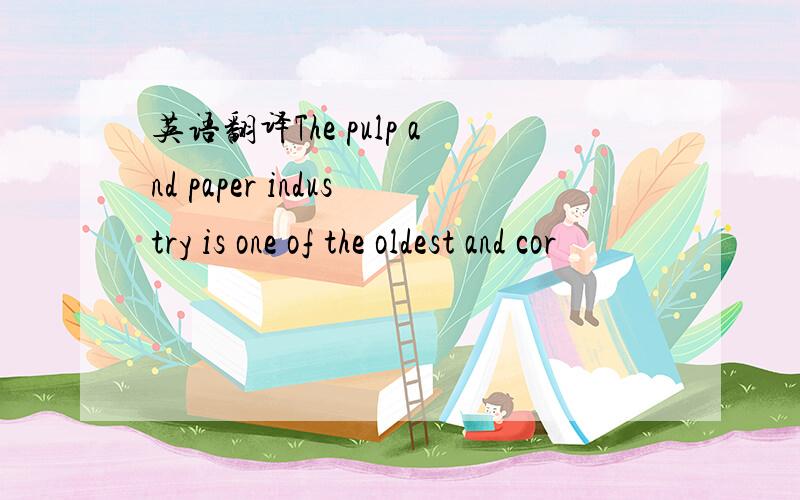英语翻译The pulp and paper industry is one of the oldest and cor
来源:学生作业帮 编辑:神马作文网作业帮 分类:英语作业 时间:2024/11/19 12:08:12
英语翻译
The pulp and paper industry is one of the oldest and core
industrial sector in India.It is a highly capital,energy,and water
intensive industry.It is also a highly polluting process and requires
substantial investments in pollution control equipments.India
produces 6million tonnes of paper per year though 311 mills
by consuming around 900millionm3 of water and discharging
700millionm3 of wastewater.Out of these about 270 small paper
mills (capacity≤10 000 tonnes per annum (TPA),having a total
installed capacity of 1.47MTPA) do not have chemical recovery
units [1].India’s current average fresh specific water consumption
for large-scale wood based pulp and paper mill,of about
150m3 per tonne of product is far above the global best specific
water consumption of 28.66m3 per tonne.This large gap is primarily
attributed to the use of obsolete technology/equipments and
poor water management practices.The large water requirements
and consumption by the Indian pulp and paper industries has led
to,water fast becoming a scarce commodity and lowering of the
ground water table and thus increased pumping costs and more
importantly water shortages in many regions.
The most significant sources of pollution among various process
stages in pulp and paper industry are wood preparation,pulping,
pulpwashing,bleaching and papermachine and coating operations.
Common pollutants include suspended solids,oxygen demanding
wastes,color,basicity,heavy metals,alkali and alkaline earth metals,
phenols,chloro-organics,cyanide,sulphides and other soluble
substances [2].The resultant effects on the environment are slime
growth,thermal impacts,scum formation,color problems and loss
of aesthetic beauty.They also increase the amount of toxic substances
in water,causing death to the zooplankton and fish,as well
as profoundly affecting the terrestrial ecosystem [3].
Conventionally pulp and paper industries in India employ
biological method of wastewater treatment.Even though the
preliminary and primary step of the process improves the
biodegradability index (BI),it seldom crosses 0.3.Thus the biological
step is slow and demands larger reactor volume.Morais and
Zamora [34] reported that samples with biodegradability index
(defined as the ratio of BOD to COD) smaller than 0.3 are not
appropriate for biological degradation.According to Chamarro et
al.[35] for complete biodegradation,the effluent must present
a biodegradability index of at least 0.4.Other treatment alternatives
such as adsorption [4],wet oxidation [5],ozone treatment
[6],fractional precipitation [7],ultra filtration [8],combined
biological and membrane based treatment [9] etc.are still questionable
on their technical and economic feasibility in large-scale
operation.
最好不要用翻译软件,读不通,不符合逻辑,
The pulp and paper industry is one of the oldest and core
industrial sector in India.It is a highly capital,energy,and water
intensive industry.It is also a highly polluting process and requires
substantial investments in pollution control equipments.India
produces 6million tonnes of paper per year though 311 mills
by consuming around 900millionm3 of water and discharging
700millionm3 of wastewater.Out of these about 270 small paper
mills (capacity≤10 000 tonnes per annum (TPA),having a total
installed capacity of 1.47MTPA) do not have chemical recovery
units [1].India’s current average fresh specific water consumption
for large-scale wood based pulp and paper mill,of about
150m3 per tonne of product is far above the global best specific
water consumption of 28.66m3 per tonne.This large gap is primarily
attributed to the use of obsolete technology/equipments and
poor water management practices.The large water requirements
and consumption by the Indian pulp and paper industries has led
to,water fast becoming a scarce commodity and lowering of the
ground water table and thus increased pumping costs and more
importantly water shortages in many regions.
The most significant sources of pollution among various process
stages in pulp and paper industry are wood preparation,pulping,
pulpwashing,bleaching and papermachine and coating operations.
Common pollutants include suspended solids,oxygen demanding
wastes,color,basicity,heavy metals,alkali and alkaline earth metals,
phenols,chloro-organics,cyanide,sulphides and other soluble
substances [2].The resultant effects on the environment are slime
growth,thermal impacts,scum formation,color problems and loss
of aesthetic beauty.They also increase the amount of toxic substances
in water,causing death to the zooplankton and fish,as well
as profoundly affecting the terrestrial ecosystem [3].
Conventionally pulp and paper industries in India employ
biological method of wastewater treatment.Even though the
preliminary and primary step of the process improves the
biodegradability index (BI),it seldom crosses 0.3.Thus the biological
step is slow and demands larger reactor volume.Morais and
Zamora [34] reported that samples with biodegradability index
(defined as the ratio of BOD to COD) smaller than 0.3 are not
appropriate for biological degradation.According to Chamarro et
al.[35] for complete biodegradation,the effluent must present
a biodegradability index of at least 0.4.Other treatment alternatives
such as adsorption [4],wet oxidation [5],ozone treatment
[6],fractional precipitation [7],ultra filtration [8],combined
biological and membrane based treatment [9] etc.are still questionable
on their technical and economic feasibility in large-scale
operation.
最好不要用翻译软件,读不通,不符合逻辑,

[1]纸浆和造纸工业是世界上最古老和核心印度工业部门.这是一个高度资金,能源,水密集的行业.这也是一个高污染的过程,需要在污染控制设备的大量投资.印度虽然311厂生产的每年600万吨纸通过围绕水和排放900万立方米消费700万立方米废水.在这些小纸270米尔斯(容量≤10万吨每年(TPA)的,有一个总装机容量1.47MTPA能力)没有化学回收单位.[2]印度目前的平均淡水具体用水量大型木质纸浆和造纸厂,约每每吨产品一百五十○立方米远高于全球最好的具体用水量每吨二十八点六六立方米.这个大的差距主要是由于过时的技术的使用/设备不良的水管理做法.水的需求大消费由印度纸浆和造纸工业已导致到,水迅速成为一种稀有商品和降低地下水位,从而增加更多的抽水费用在许多地区重要的水资源短缺问题.污染最重要的来源各进程在制浆造纸工业是木材阶段的准备,制浆,pulpwashing(我也不知道是什么意思),漂白和造纸机及涂布作业.常见的污染物包括悬浮物,氧气要求废物,颜色,碱度,重金属,碱,碱土金属,酚,氯有机物,氰化物,硫化物和其他可溶性物质.[3]对环境造成的影响的煤泥增长,热影响,浮渣,颜色问题和损失的美感.他们还增加了有毒物质的数量在水中,造成死亡的浮游动物和鱼类,以及作为深刻影响陆地生态系统.[4]传统纸浆和造纸工业在印度雇用生物法处理废水.即使初步的和主要的流程步骤改善生物降解性指数(BI),它很少跨越0.3.因此,生物步骤是缓慢的,要求有更大的反应器体积.德莫赖斯和萨莫拉[34]报道,样品的生物降解性指数(定义为生化需氧量COD的比值)小于0.3顷不适当的生物降解.据查马罗等报.[35完全生物降解],污水必须出示至少0.4生物降解性指标.其他处理办法
如吸附,[5]湿式氧化,[6]臭氧处理,[7]分级沉淀,[8]超过滤,[9]组合生物和膜为基础的治疗等等,仍然值得商榷其技术和经济可行性的大型操作.
楼主,你看这样行不?行的话请采纳,
如吸附,[5]湿式氧化,[6]臭氧处理,[7]分级沉淀,[8]超过滤,[9]组合生物和膜为基础的治疗等等,仍然值得商榷其技术和经济可行性的大型操作.
楼主,你看这样行不?行的话请采纳,
英语翻译The pulp and paper industry is one of the oldest and cor
Underline the mistakes and cor
英语翻译The University of Cambridge is one of the oldest univers
英语翻译Is the spray room's T/H controlled and specification cor
but the company is one of the oldest transatlantic shipping
who is the oldest one of the two girls?改错
英语翻译Security and privacy is always one of the mostconcerned
英语翻译The oldest and most important festival in China is the S
英语翻译which was founded in 1877,is one of the oldest higher in
英语翻译一 翻译(英译汉)(共100分)Crystallization is one of the oldest uni
英语翻译The oldest and most common source(来源) of renewable energ
英语翻译The Italian Dental Industry is one of the most important